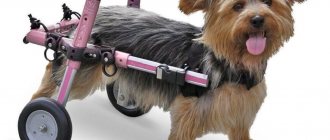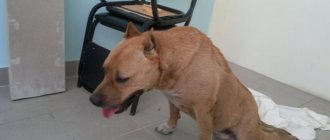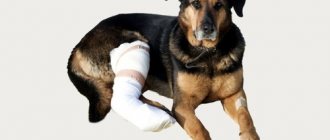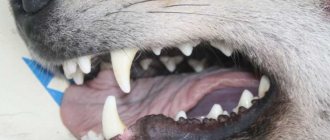Almost every owner dreams of his puppy and adult four-legged pet being healthy and happy. And noticing that the dear barking family member begins to drag his hind legs, walks unsteadily or trembles, the owner begins to panic and does not know what to do. You should not try to diagnose your dog yourself; it is best to seek help from a veterinarian.
Of course, it is best to find out in advance what can lead to impaired motor function in a dog. Yes, this knowledge cannot protect the animal, but it can help the owner notice in time that something is wrong with the pet. And if the puppy is sick, then timely treatment will help make the future life easier for the baby.
Content
1. How to determine that a dog’s paws are moving apart? 2. Discopathy 3. Mechanical injury 4. In this case it is necessary: 5. Diseases of the joints 6. How to treat? 7. Prevention
Sometimes, while walking down the street or in the park, you can meet owners with pets who have an “original” gait. The dog’s paws literally move out of the blue, and the owners perceive this as a funny aspect or a meaningless situation.
I would like to explain to such pet owners that this kind of animal behavior is not an attempt to make you laugh or just fool around, it is a sign of an illness, serious or not so serious, that needs to be sorted out. But under no circumstances should the situation be left as it is.
How can you tell if your dog's paws are coming apart?
The symptoms of the problem are quite eloquent and it is quite difficult to confuse it with some other options.
- The animal has a clearly unbalanced gait; the dog wobbles from side to side when walking.
- When moving, the dog seems to hunch over, trying to move the bulk of its body weight onto its front paws. Often this symptom manifests itself in cases where it is necessary to make an effort to perform some intended action, such as overcoming an obstacle on the street or simply jumping onto your lap in a chair.
- At some point in time, you begin to notice that the dog’s paws begin to tremble, and it is difficult for him to even eat normally from a bowl.
- Frequent constipation, diarrhea, and problems with urination should give you pause.
There are cases when the disease develops from the initial stage to the critical stage in just a couple of days. In this case, rapidly developing paralysis of the hind limbs may occur. Half of the body is completely immobilized, and the paws simply drag behind the body.
Treatment
The described pathology is treated by two methods - medication and surgery. The chosen method depends on the individual characteristics of the animal, the degree of disease, the age category and body weight of the dog. The speed of development of the pathology and the general well-being of the pet are also important.
Conservative treatment includes several components. First of all, medications of various action groups are prescribed:
- chondroprotectors - the effect is aimed at stopping pathological changes and restoring affected tissues, drugs are administered intramuscularly, intravenously or directly into the joint itself
- anti-inflammatory drugs – relief of inflammation
- antispasmodics – reduction of pain, relief of general condition
- homeopathic medicines – have a supportive, preventive effect
- food supplements containing glucosamine and chondroitin help strengthen bone tissue and regenerate joints
Along with medications, physiotherapy is prescribed. If necessary, paraffin therapy, ozokerite, magnetic and laser therapy are prescribed. Massage of affected joints has a positive effect. But only a competent specialist can perform it, determine the number of necessary sessions and their duration. For treatment to be effective, moderate physical activity is required - swimming, walking, light jogging.
Don't forget about your pet's diet. This is of particular concern if the disease is acquired due to obesity. It is important to get rid of excess weight; the dog is put on a low-calorie diet and the weight loss process is monitored. During this period, vitamin complexes are necessarily used.
If the disease is severe, conservative treatment will not have the desired effect, and the pet’s condition may worsen significantly. In this case, the optimal solution is surgery to correct the shape of the head of the bone to ensure a tight fit to the glenoid cavity.
Before the operation, a repeat x-ray is prescribed. The complexity and duration of the procedure directly depends on the severity of the disease. In the simplest version, cartilage removal will be required. In severe cases, one of the following types of surgery is prescribed:
- Arthroplasty is complete or partial excision of the head and neck of the femur. The procedure is prescribed for advanced stages of the disease with irreversible consequences when the disease develops into osteoarthritis. During the operation, no prosthetics are implanted into the body. Rehabilitation takes a long period of time, but after it is over, the pet completely forgets about the disease.
- Osteotomy is a surgical procedure that involves changing the position of the articular cavity. As a result, the head of the bone takes the correct position in the joint, restoring the position of the limb. The operation is performed at the initial and mild stage of the pathology.
- Endoprosthetics is the replacement of affected joints with prostheses made of titanium alloy. There is a risk that the body may reject the prosthesis, but in most cases they take root successfully. The operation process is quite complex and lengthy, as is the rehabilitation process. But with full recovery, the dog will be able to move calmly without experiencing discomfort and return to moderate exercise.
Discopathy
This disease is characterized by destruction of the integrity of the spine, when the distance between individual vertebrae increases, and the intervertebral disc wears out and falls out. This often leads to the spinal cord being pinched or, in extreme cases, even torn. In the first case, with timely, professional help, it is quite possible to achieve a certain remission. In the second, there is no chance.
A herniated disc also leads to the same problems. At the same time, the dog’s paws move apart, and while moving, it actively shows signs of pain. Often he prefers to just lie down in one comfortable position. Self-medication of these diseases is unacceptable; it is necessary to contact a veterinary clinic as quickly as possible for qualified help, before it is too late.
Diagnostics
Prescribing treatment on your own is unacceptable and can lead to serious problems. Only a specialist can determine the exact diagnosis and its stage of development. Diagnosis of the disease involves a visual examination of the animal. The veterinarian conducts a mobility test - flexion, extension of the joints and listening to sounds (clicks, squeaks, friction) during this process. This stage allows you to determine the presence of pathology.
To clarify the degree of joint deformation, an x-ray is prescribed. It is performed under anesthesia to ensure complete immobility of the patient. The finished image allows you to determine the exact location of the glenoid cavity and the head of the bone.
A more accurate examination of damaged joints is carried out using arthroscopy. The procedure allows you to examine the tissue structure using a miniature camera inserted into the joint cavity with a small puncture. Such research is highly accurate and informative. But it can only be carried out in modern, technologically equipped clinics.
After all the research, the specialist determines the degree of dysplasia. The general condition of dog joints is divided into several categories:
- A (no obvious signs of disease)
- B (predisposition to pathology)
- C (initial stage of the pathological process)
- D (presence of violations within the acceptable limits)
- E (severe deformation of articular tissues)
Mechanical injury
Mechanical injuries, after which the dog’s paws move apart, pose a great danger to health. Unfortunately, any animal can be injured, and no one is immune from this. You can fall into a hole or slip on a slippery surface, fight on the street with another dog, or get hit by vehicles, of which there are more and more of them. But you never know under what circumstances injury is possible?
If you see that your pet has suffered mechanical damage, then take a closer look at the animal. The optimal solution in this situation seems to be to seek help from veterinarians. However, if upon visual observation there are no serious manifestations (the dog’s legs move apart, it whines and does not allow the bruised area to be touched, or shows other signs of inappropriate behavior), it can be treated at home.
Answer
Old dogs get tired easily, sleep a lot, move little, rarely play and have difficulty hearing. An elderly pet does not please the owner with energy and enthusiasm. An old dog finds a secluded, cozy corner in which he can lie all day. The character becomes capricious and touchy, the dog is able to not respond to the owner’s call.
Unfortunately, pets age faster than their owners want. The onset of old age depends on the breed and size of the animal. Often dogs become old at 10 years old, but with proper care and care they live to be 20. Sometimes veterinarians advise euthanizing an old dog. The decision to euthanasia depends on the situation. You should help the animal live a long time and please its owners with your love.
In this case it is necessary:
| Strengthen control. | |
| Provide complete rest to the animal. | |
| Reduce the time and distance of walking as much as possible, eliminate any training or physical activity. | |
| Diversify your diet by saturating your food with vitamins and minerals. | |
| If such a possibility exists, invite a doctor to your home, at least for an initial consultation. |
By the way, pets with long bodies, such as dachshunds, are prone to self-injury.
In some cases, it is enough to simply turn carelessly, or, in case of fright, to get a spinal injury, the dog’s paws move in different directions at once.
Joint diseases
Animal joints also do not last forever; they can wear out, transform, and become inflamed.
In the vast majority of cases, problems arise with the hip joint. The disease most often affects large, heavy dogs such as Labradors and Dobermans, as well as overweight pets. It would seem that we pamper our dogs, delighting them with a variety of goodies. But ultimately, all this leads to obesity and the development of a large number of different problems. And believe me, if the dog’s paws are just moving apart, this is not the worst option.
The following factors can also lead to joint problems:
- the presence of a genetic predisposition, unfortunately, it is impossible to prevent this;
- low physical activity - the dog does not walk much, is constantly on a chain or in a confined, cramped space;
- unhealthy diet with calcium restrictions.
In some cases, for example, with dysplasia, you cannot count on complete healing. However, modern veterinary technologies and materials make it possible to achieve a very high quality of life for sick pets.
Myositis
This disease is not critical, but can also cause situations where the dog’s paws move apart. Essentially, we are talking about excessive stress, after which the pet develops certain muscle inflammations. By the way, this disease can also be of a viral nature.
Stroke
Many dog owners don't even realize that their beloved pets can also have a stroke. But vestibular syndrome is even more common. In both cases, an approximately similar clinical picture is observed:
- The presence of restlessness or anxiety in the animal.
- The dog starts spinning around in one place for no reason, as if chasing his own tail. It would seem that a comical picture actually means very serious problems for the dog with a high probability of death. Do not hesitate, be sure to seek help from veterinarians.
- The eyes are directed upward, and breathing becomes very heavy, with shortness of breath.
- Inappropriate behavior manifests itself, as an option, it can fall on its side or back, just like when it wants to play.
It is important to understand that all these signs will increase during a stroke, and very quickly. With vestibular syndrome, they appear quickly, absolutely without any reason, and just as quickly and “know where” they disappear. After some time, the symptoms repeat. It is clear that over time the “attacks” will become more frequent and lengthen in time. But it is advisable to start treatment as early as possible; only in this case can we talk about positive prospects and a return to a full, high-quality life.
Characteristic features of the disease
Dysplasia is a pathology that destroys or modifies articular tissue, associated with improper fit of the head of the bone to the glenoid cavity. In a healthy dog, the fit is quite tight, ensuring smooth gliding and elasticity of this design. With dysplasia, there is a gap between the bone and the niche where it fits, this causes friction of the tissues, leading to their separation and flattening. Subsequently, the articular cartilage succumbs to strong pressure and becomes deformed.
The described disease is not congenital, but quite often develops in early childhood. By taking an x-ray, the veterinarian can easily determine the presence of dysplasia even at the initial stage. In the absence of proper attention, pronounced symptoms and deformation of the musculoskeletal joint become noticeable by the year of the dog’s life. In the period from one to one and a half years, the structure of the body is formed and its intensive growth ends; during this period it is easy to determine the condition of the pet’s joint tissues.
Dogs of large breeds are predisposed to the appearance of this pathology - St. Bernards, shepherds, retrievers, Labradors and others. Dysplasia affects various groups of joints of the musculoskeletal system and is divided into several types:
- Damage to the hip joint (HJ) is the most common form, due to the peculiarity of the hind legs of dogs. When running or jumping, the dog leans and pushes off with its hind legs, using them as shock absorption.
- Elbow joint damage is abnormal growth of tissue cells in the elbow or knee area and is the main cause of severe lameness and chronic pain in your pet.
- Damage to the knee joint is a rare type, associated with improper care and maintenance of the animal, or a previous injury.
How to treat?
It should be noted right away that it is impossible to treat any of the above diseases on your own, with the possible exception of myositis, at home and, especially, on your own. This will 100% lead to the death of the pet. Veterinarians must be involved. But even myositis is almost impossible for a person whose professional training is far from veterinary medicine to diagnose - there is a possibility of overlooking more serious ailments.
Again, as practice shows, an animal gets to the doctors not when the dog’s paws move apart, but when it is completely or partially paralyzed. In this situation, restoring the mobility of the limbs and ensuring a normal existence is extremely difficult. For this reason, bring your pets to the veterinarians in a timely manner.











